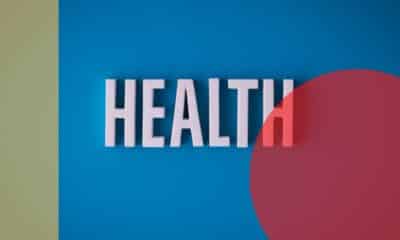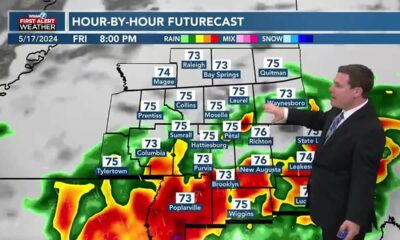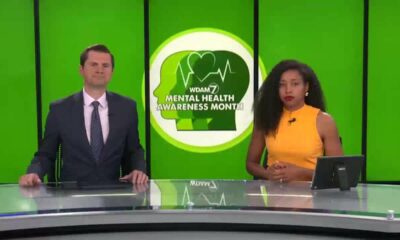Kaiser Health News
Congressman Off-Base in Ad Claiming Fauci Shipped Covid to Montana Before the Pandemic
Katheryn Houghton
Mon, 05 Feb 2024 10:00:00 +0000
“IT'S BEEN REVEALED THAT FAUCI BROUGHT COVID TO THE MONTANA ONE YEAR BEFORE COVID BROKE OUT IN THE U.S!”
An ad from the Matt Rosendale for Montana campaign
A fundraising ad for U.S. Rep. Matt Rosendale (R-Mont.) shows a photo of Anthony Fauci, former director of the National Institute of Allergy and Infectious Diseases, behind bars, swarmed by flying bats.
Rosendale, who is eyeing a challenge to incumbent Sen. Jon Tester, a Democrat, maintains that a Montana biomedical research facility, Rocky Mountain Laboratories in Hamilton, has a dangerous link to the pandemic. This claim is echoed in the ad:
“It's been revealed that Fauci brought COVID to the Montana one year before COVID broke out in the U.S!,” it charges in all-caps before asking readers to “Donate today and hold the D.C. bureaucracy accountable!”
The ad, paid for by Matt Rosendale for Montana, seeks contributions through WinRed, a platform that processes donations for Republican candidates. Rosendale also shared the fundraising pitch on his X account Nov. 1, and it remained live as of early February.
Rosendale made similar accusations on social media, during a November speech on the U.S. House floor, and through his congressional office. Sometimes his comments, like those on the House floor, are milder, saying the researchers experimented on “a coronavirus” leading up to the pandemic. Other times, as in an interview with One America News Network, he linked the lab's work to covid-19's spread.
In that interview clip, Rosendale recounted pandemic-era shutdowns before saying, “And now we're finding out that the National Institute of Health, Rocky Mountain Lab, down in Hamilton, Montana, had also played a role in this.”
Rosendale's statements echo broader efforts to scrutinize how research into viruses happens in the United States and is part of a continued wave of backlash against scientists who have studied coronaviruses. Rosendale is considering seeking the Republican nomination to challenge Tester, in a toss-up race that could help determine which party controls the Senate in 2025. Political newcomer Tim Sheehy is also seeking the Republican nomination for the Senate.
Rosendale proposed amendments to a health spending bill that would ban pandemic-related pathogen research funding for Rocky Mountain Laboratories and cut the salary of one of its top researchers, virologist Vincent Munster, to $1. The House has included both amendments in the Health and Human Services budget bill that the Republican majority hopes to pass. A temporary spending bill is funding the health department until March.
We contacted Rosendale's congressional office multiple times — with emails, a phone call, and an online request — asking what proof he had to back up his statements that the Montana lab infected bats with covid from China before the outbreak. We got no reply.
Kathy Donbeck, of the National Institute of Allergy and Infectious Diseases' Office of Communications and Government Relations, said in an email that the ad's claims are false. Interviews with virologists and a review of the research paper published shortly before Rosendale's assertions support that position.
Where This Is Coming From
Rosendale's statements seem to stem from a Rocky Mountain Laboratories study from 2016 that looked into how a coronavirus, WIV1-CoV, acted in Egyptian fruit bats. The work, published by the journal Viruses in 2018, showed that the specific strain didn't cause a robust infection in the bats.
The study did not receive widespread attention at the time. But on Oct. 30, 2023, the study was highlighted by a blog called White Coat Waste Project, which says its mission is to stop taxpayer-funded experiments on animals. Some right-wing media outlets began to connect the Montana lab with the coronavirus that causes covid.
Rosendale's office issued an Oct. 31 news release saying the Wuhan Institute of Virology in China “shipped a strain of coronavirus” to the Hamilton lab. “Our government helped create the Wuhan flu, then shut the country down when it escaped from the lab,” Rosendale said.
It's a Different Virus
Rocky Mountain Laboratories is a federally funded facility as part of NIAID, the nation's top infectious disease research agency, which Fauci led for nearly 40 years.
According to the study and Donbeck's email, the Montana researchers focused on a coronavirus called WIV1-CoV, not the covid-causing SARS-CoV-2. They're different viruses.
“The genetics of the viruses are very different, and their behavior biologically is very different,” said Troy Sutton, a virologist with Pennsylvania State University who has studied the evolution of pandemic influenza viruses.
In a review of media reports on the Montana study, Health Feedback, a network of scientists that fact-checks health and medical media coverage, showed the virus's lineage indicated that WIV1 “is not a direct ancestor or even a close relative of SARS-CoV-2.”
Additionally, the description of the coronavirus strain as being “shipped” suggests that it physically traveled across the world. That's not what happened.
The Wuhan Institute of Virology provided the WIV1 virus's sequence that allowed researchers to make a lab-grown copy. A separate study, published in 2013 by the journal Nature, outlines the origins of the lab-created virus.
According to the study's methodology, the researchers used a clone of WIV1. An NIAID statement to Lee Enterprises, a media company, said the virus “was generated using common laboratory techniques, based on genetic information that was publicly shared by Chinese scientists.”
Stanley Perlman, a University of Iowa professor who studies coronaviruses and serves on the federal advisory committee that reviews vaccines, said Rosendale's claim is off-base.
He said Rosendale's focus on where the lab got its materials is irrelevant and serves “only to make people wary and scared.”
Rosendale's efforts to prohibit particular research at Rocky Mountain Laboratories appear ill-informed, too. Rosendale targeted banning gain-of-function research, which involves altering a pathogen to study its spread. In her email, NIAID's Donbeck said the Rocky Mountain Laboratories study didn't involve gain-of-function research.
This type of research has long been controversial, and people who study viruses have said the definition of “gain of function” is problematic and insufficient to show when research, or even work to create vaccines, could cross into that type of research.
But both Sutton and Perlman said that, any way you look at it, the Rocky Mountain Laboratories study published in 2018 didn't change the virus. It put a virus in bats and showed it didn't grow.
And it had no effect on the covid outbreak a year later, first detected in Washington state.
Our Ruling
Rosendale's ad said, “It's been revealed that Fauci brought COVID to the Montana one year before COVID broke out in the U.S!” The campaign ad and Rosendale's similar statements refer to research at the Rocky Mountain Laboratories involving WIV1, a coronavirus that researchers say is not even distantly close in genetic structure to SARS-CoV-2, the virus that caused covid-19.
Rosendale's claim is wrong about when the scientists began their work, what they were studying, and where they got the materials. The researchers began their work in 2016 and, although they were studying a coronavirus, it wasn't the virus that causes covid. The Montana scientists used a lab-grown clone of WIV1 for their research. The first laboratory-confirmed case of covid was not detected in the U.S. until Jan. 20, 2020. Rosendale's ad is inaccurate and ridiculous. We rate it Pants on Fire!
Sources:
Viruses, “SARS-Like Coronavirus WIV1-CoV Does Not Replicate in Egyptian Fruit Bats (Rousettus aegyptiacus),” Dec. 19, 2018
White Coat Waste Project, “Horror Show: Shady Zoo Sent Bats to NIH to Be Infected With a Wuhan Lab Coronavirus,” Oct. 30, 2023
MattForMontana X post, Nov. 1, 2023
Campaign ad, accessed Dec. 14, 2023
Rep. Matt Rosendale, House floor speech, Nov. 14, 2023
One America News Network, interview, accessed Dec. 14, 2023
Rosendale congressional office, “Rep. Rosendale Reacts to Reports That Wuhan Lab Shipped Coronavirus to Fauci-Run Lab in Hamilton Prior to Pandemic,” Oct. 31, 2023
National Institute of Allergy and Infectious Diseases, “History of Rocky Mountain Labs (RML),” accessed Dec. 14, 2023
Email exchange with NIAID, beginning Dec. 14, 2023
Statement from NIAID provided to Lee Enterprises, accessed Jan. 2, 2024
Nature, “Isolation and Characterization of a Bat SARS-Like Coronavirus That Uses the ACE2 Receptor,” Oct. 30, 2013
Ravalli Republic, “Rosendale Moves to Strip Rocky Mountain Lab Research Funding,” Nov. 17, 2023
Interview, Troy Sutton, assistant professor of veterinary and biomedical sciences at Pennsylvania State University, Jan. 5, 2024
Interview, Stanley Perlman, professor of microbiology and immunology and professor of pediatrics at the University of Iowa, Jan. 13, 2024
FDA, “Roster of the Vaccines and Related Biological Products Advisory Committee,” accessed Jan. 16, 2024
Health Feedback, “2018 Coronavirus Research in NIAID Montana Lab Is Unrelated to the COVID-19 Pandemic, Contrary to Claim by Fox News's Jesse Watters,” last accessed Jan. 17, 2024
Email exchange with OpenSecrets, an independent research group tracking money in politics, beginning Jan. 30, 2024
CDC Museum COVID-19 Timeline, accessed Feb. 2, 2024
KFF Health News is a national newsroom that produces in-depth journalism about health issues and is one of the core operating programs at KFF—an independent source of health policy research, polling, and journalism. Learn more about KFF.
USE OUR CONTENT
This story can be republished for free (details).
——————————
By: Katheryn Houghton
Title: Congressman Off-Base in Ad Claiming Fauci Shipped Covid to Montana Before the Pandemic
Sourced From: kffhealthnews.org/news/article/us-rep-matt-rosendale-covid-19-claims-against-rocky-mountain-laboratories/
Published Date: Mon, 05 Feb 2024 10:00:00 +0000
Did you miss our previous article…
https://www.biloxinewsevents.com/advocates-say-a-practice-harms-disabled-children-yet-congressional-action-is-stalled/
Kaiser Health News
Watch: John Oliver Dishes on KFF Health News’ Opioid Settlements Series
Fri, 17 May 2024 09:00:00 +0000
Opioid manufacturers, distributors, and retailers are paying tens of billions of dollars in restitution to settle lawsuits related to their role in the nation's overdose epidemic. A recent broadcast of “Last Week Tonight With John Oliver” examined how that money is being spent by state and local governments across the United States.
The segment featured reporting from the KFF Health News series “Payback: Tracking the Opioid Settlement Cash.” You can learn more about the issue and read our collection of articles by Aneri Pattani here.
——————————
Title: Watch: John Oliver Dishes on KFF Health News' Opioid Settlements Series
Sourced From: kffhealthnews.org/news/article/watch-john-oliver-kff-health-news-payback-opioid-settlements-series/
Published Date: Fri, 17 May 2024 09:00:00 +0000
Kaiser Health News
KFF Health News’ ‘What the Health?’: Bird Flu Lands as the Next Public Health Challenge
Thu, 16 May 2024 18:30:00 +0000
The Host
Julie Rovner is chief Washington correspondent and host of KFF Health News' weekly health policy news podcast, “What the Health?” A noted expert on health policy issues, Julie is the author of the critically praised reference book “Health Care Politics and Policy A to Z,” now in its third edition.
Public health officials are watching with concern since a strain of bird flu spread to dairy cows in at least nine states, and to at least one dairy worker. But in the wake of covid-19, many farmers are loath to let in health authorities for testing.
Meanwhile, another large health company — the Catholic hospital chain Ascension — has been targeted by a cyberattack, leading to serious problems at some facilities.
This week's panelists are Julie Rovner of KFF Health News, Rachel Cohrs Zhang of Stat, Alice Miranda Ollstein of Politico, and Sandhya Raman of CQ Roll Call.
Panelists
Rachel Cohrs Zhang
Stat News
Alice Miranda Ollstein
Politico
Sandhya Raman
CQ Roll Call
Among the takeaways from this week's episode:
- Stumbles in the early response to bird flu bear an uncomfortable resemblance to the early days of covid, including the troubles protecting workers who could be exposed to the disease. Notably, the Department of Agriculture benefited from millions in covid relief funds designed to strengthen disease surveillance.
- Congress is working to extend coverage of telehealth care; the question is, how to pay for it? Lawmakers appear to have settled on a two-year agreement, though more on the extension — including how much it will cost — remains unknown.
- Speaking of telehealth, a new report shows about 20% of medication abortions are supervised via telehealth care. State-level restrictions are forcing those in need of abortion care to turn to options farther from home.
- And new reporting on Medicaid illuminates the number of people falling through the cracks of the government health system for low-income and disabled Americans — including how insurance companies benefit from individuals' confusion over whether they have Medicaid coverage at all.
Also this week, Rovner interviews Atul Grover of the Association of American Medical Colleges about its recent analysis showing that graduating medical students are avoiding training in states with abortion bans and major restrictions.
Plus, for “extra credit,” the panelists suggest health policy stories they read this week that they think you should read, too:
Julie Rovner: NPR's “Why Writing by Hand Beats Typing for Thinking and Learning,” by Jonathan Lambert.
Alice Miranda Ollstein: Time's “‘I Don't Have Faith in Doctors Anymore.' Women Say They Were Pressured Into Long-Term Birth Control,” by Alana Semuels.
Rachel Cohrs Zhang: Stat's “After Decades Fighting Big Tobacco, Cliff Douglas Now Leads a Foundation Funded by His Former Adversaries,” by Nicholas Florko.
Sandhya Raman: The Baltimore Banner's “People With Severe Mental Illness Are Stuck in Jail. Montgomery County Is the Epicenter of the Problem,” by Ben Conarck.
Also mentioned on this week's podcast:
- Stat's “My Rendezvous With the Raw Milk Black Market: Quick, Easy, and Unchecked by the FDA,” by Nicholas Florko.
- The Stamford Advocate's “Dan Haar: Hackers Stole a Disabled CT Couple's SNAP Food Aid. Now They're Out $1,373,” by Dan Haar.
- WKRN's “‘Chaos': Nurses, Visitors Describe Conditions Inside Ascension Hospitals After Cyberattack,” by Stephanie Langston.
- KFF Health News' “Medicaid ‘Unwinding' Decried as Biased Against Disabled People,” by Daniel Chang.
- KFF Health News' “Why Medicaid's ‘Undercount' Problem Counts,” by Phil Galewitz.
Credits
Francis Ying
Audio producer
Emmarie Huetteman
Editor
To hear all our podcasts, click here.
And subscribe to KFF Health News' “What the Health?” on Spotify, Apple Podcasts, Pocket Casts, or wherever you listen to podcasts.
——————————
Title: KFF Health News' ‘What the Health?': Bird Flu Lands as the Next Public Health Challenge
Sourced From: kffhealthnews.org/news/podcast/what-the-health-347-bird-flu-next-public-health-challenge-may-16-2024/
Published Date: Thu, 16 May 2024 18:30:00 +0000
Kaiser Health News
California’s $12 Billion Medicaid Makeover Banks on Nonprofits’ Buy-In
Angela Hart
Thu, 16 May 2024 09:00:00 +0000
TURLOCK, Calif. — For much of his young life, Jorge Sanchez regularly gasped for air, at times coughing so violently that he'd almost throw up. His mother whisked him to the emergency room late at night and slept with him to make sure he didn't stop breathing.
“He's had these problems since he was born, and I couldn't figure out what was triggering his asthma,” Fabiola Sandoval said of her son, Jorge, now 4. “It's so hard when your child is hurting. I was willing to try anything.”
In January, community health workers visited Sandoval's home in Turlock, a city in California's Central Valley where dust from fruit and nut orchards billows through the air. They scoured Sandoval's home for hazards and explained that harsh cleaning products, air fresheners, and airborne dust and pesticides can trigger an asthma attack.
The team also provided Sandoval with air purifiers, a special vacuum cleaner that can suck dust out of the air, hypoallergenic mattress covers, and a humidity sensor — goods that retail for hundreds of dollars. Within a few months, Jorge was breathing easier and was able to run and play outside.
The in-home consultation and supplies were paid for by Medi-Cal, California's Medicaid health insurance program for low-income residents. Gov. Gavin Newsom is spearheading an ambitious $12 billion experiment to transform Medi-Cal into both a health insurer and a social services provider, one that relies not only on doctors and nurses, but also community health workers and nonprofit groups that offer dozens of services, including delivering healthy meals and helping homeless people pay for housing.
These groups are redefining health care in California as they compete with businesses for a share of the money, and become a new arm of the sprawling Medi-Cal bureaucracy that serves nearly 15 million low-income residents on an annual budget of $158 billion.
But worker shortages, negotiations with health insurance companies, and learning to navigate complex billing and technology systems have hamstrung the community groups' ability to deliver the new services: Now into the third year of the ambitious five-year experiment, only a small fraction of eligible patients have received benefits.
“This is still so new, and everyone is just overwhelmed at this point, so it's slow-going,” said Kevin Hamilton, a senior director at the Central California Asthma Collaborative.
The collaborative has served about 3,650 patients, including Sandoval, in eight counties since early 2022, he said. It has years of experience with Medi-Cal patients in the Central Valley and has received about $1.5 million of the new initiative's money.
By contrast, CalOptima Health, Orange County's primary Medi-Cal insurer, is new to offering asthma benefits and has signed up 58 patients so far.
“Asthma services are so difficult to get going” because the nonprofit infrastructure for these services is virtually nonexistent, said Kelly Bruno-Nelson, CalOptima's executive director for Medi-Cal. “We need more community-based organizations on board because they're the ones who can serve a population that nobody wants to deal with.”
Newsom, a Democrat in his second term, says his signature health care initiative, known as CalAIM, seeks to reduce the cost of caring for the state's sickest and most vulnerable patients, including homeless Californians, foster children, former inmates, and people battling addiction disorders.
In addition to in-home asthma remediation, CalAIM offers 13 broad categories of social services, plus a benefit connecting eligible patients with one-on-one care managers to help them obtain anything they need to get healthier, from grocery shopping to finding a job.
The 25 managed-care insurance companies participating in Medi-Cal can choose which services they offer, and contract with community groups to provide them. Insurers have hammered out about 4,300 large and small contracts with nonprofits and businesses.
So far, about 103,000 Medi-Cal patients have received CalAIM services and roughly 160,000 have been assigned personal care managers, according to state data, a sliver of the hundreds of thousands of patients who likely qualify.
“We're all new to health care, and a lot of this is such a foreign concept,” said Helena Lopez, executive director of A Greater Hope, a nonprofit organization providing social services in Riverside and San Bernardino counties, such as handing out baseball cleats to children to help them be active.
Tiffany Sickler runs Koinonia Family Services, which offers California foster children mental health and other types of care, and even helped a patient pay off parking tickets. But the program is struggling on a shoestring budget.
“If you want to do this, you have to learn all these new systems. It's been a huge learning curve, and very time-consuming and frustrating, especially without adequate funding,” she said.
Brandon Richards, a Newsom spokesperson, defended CalAIM, saying that it was “on the cutting edge of health care” and that the state was working to increase “awareness of these new services and support.”
For nonprofits and businesses, CalAIM is a money-making opportunity — one that top state health officials hope to make permanent. Health insurers, which receive hefty payments from the state to serve more people and offer new services, share a portion with service providers.
In some places, community groups are competing with national corporations for the new funding, such as Mom's Meals, an Iowa-based company that delivers prepared meals across the United States.
Mom's Meals has an advantage over neighborhood nonprofit groups because it has long served seniors on Medicare and was able to immediately start offering the CalAIM benefit of home-delivered meals for patients with chronic diseases. But even Mom's Meals isn't reaching everyone who qualifies, because doctors and patients don't always know it's an option, said Catherine Macpherson, the company's chief nutrition officer.
“Utilization is not as high as it should be yet,” she said. “But we were well positioned, because we already had departments to do billing and contracting with health care.”
Middleman companies also have their eye on the billions of CalAIM dollars and are popping up to assist small organizations to go up against established ones like Mom's Meals. For instance, the New York-based Nonprofit Finance Fund is advising homeless service providers how to get more contracts and expand benefits.
Full Circle Health Network, with 70 member organizations, is helping smaller nonprofit groups develop and deliver services primarily for families and foster children. Full Circle has signed a deal with Kaiser Permanente, allowing the health care giant to access its network of community groups.
“We're allowing organizations to launch these benefits much faster than they've been able to do and to reach more vulnerable people,” said Camille Schraeder, chief executive of Full Circle. “Many of these are grassroots organizations that have the trust and expertise on the ground, but they're new to health care.”
One of the biggest challenges community groups face is hiring workers, who are key to finding eligible patients and persuading them to participate.
Kathryn Phillips, a workforce expert at the California Health Care Foundation, said there isn't enough seed money for community groups to hire workers and pay for new technology platforms. “They bring the trust that is needed, the cultural competency, the diversity of languages,” she said. “But there needs to be more funding and reimbursement to build this workforce.”
Health insurers say they are trying to increase the workforce. For instance, L.A. Care Health Plan, the largest Medi-Cal insurer in California, has given $66 million to community organizations for hiring and other CalAIM needs, said Sameer Amin, the group's chief medical officer.
“They don't have the staffing to do all this stuff, so we're helping with that all while teaching them how to build up their health care infrastructure,” he said. “Everyone wants a win, but this isn't going to be successful overnight.”
In the Central Valley, Jorge Sanchez is one of the lucky early beneficiaries of CalAIM.
His mother credits the trust she established with community health workers, who spent many hours over multiple visits to teach her how to control her son's asthma.
“I used to love cleaning with bleach” but learned it can trigger breathing problems, Sandoval said.
Since she implemented the health workers' recommendations, Sandoval has been able to let Jorge sleep alone at night for the first time in four years.
“Having this program and all the things available is amazing,” said Sandoval, as she pointed to the dirty dust cup in her new vacuum cleaner. “Now my son doesn't have as many asthma attacks and he can run around and be a normal kid.”
This article was produced by KFF Health News, which publishes California Healthline, an editorially independent service of the California Health Care Foundation.
——————————
By: Angela Hart
Title: California's $12 Billion Medicaid Makeover Banks on Nonprofits' Buy-In
Sourced From: kffhealthnews.org/news/article/newsom-medicaid-12-billion-dollar-makeover-nonprofits-bureacracy-calaim/
Published Date: Thu, 16 May 2024 09:00:00 +0000
-
SuperTalk FM4 days ago
Martin Lawrence making 3 stops in Mississippi on comedy tour
-
Our Mississippi Home3 days ago
Beat the Heat with Mississippi’s Best Waterparks
-
Mississippi Today7 days ago
Lawmakers may have to return to Capitol May 14 to override Gov. Tate Reeves’ potential vetoes
-
Our Mississippi Home4 days ago
Charlie’s U-Pik: Opening Soon for the Summer Season
-
Mississippi News Video6 days ago
Local dentists offer free dental care in Amory
-
Kaiser Health News3 days ago
Medicaid ‘Unwinding’ Decried as Biased Against Disabled People
-
Mississippi News7 days ago
Bond set for West Point couple accused of killing their child
-
Mississippi News Video2 days ago
Jackson has a gang problem



























![HIGH SCHOOL SOFTBALL: Vancleave @ East Central (5/9/2024) [5A Playoffs, South State]](https://www.biloxinewsevents.com/wp-content/uploads/2024/05/1715460379_maxresdefault-80x80.jpg)







